Page Content
We are going to look at what is the same and what is different among migratory, nomadic and wandering birds.
- What is Bird Migration?
- Migration Paths
- How do Birds Know When to Start Migrating?
- Grouping Migratory and Other Travelling Birds
Music: Op. 7, No. 5 – Due and Declared by Tom Fahy (http://tomfahy.org/)
What is Bird Migration?
Answer: Bird migration is a process of movement, typically seasonal, from one geographic region to another. The purpose is usually the need for food supply which becomes scarce and difficult to obtain during a harsh winter or a dry summer.
With some species migration also coincides with breeding. The distance of migration can vary between dozens to thousands of kilometers and may take weeks to complete.
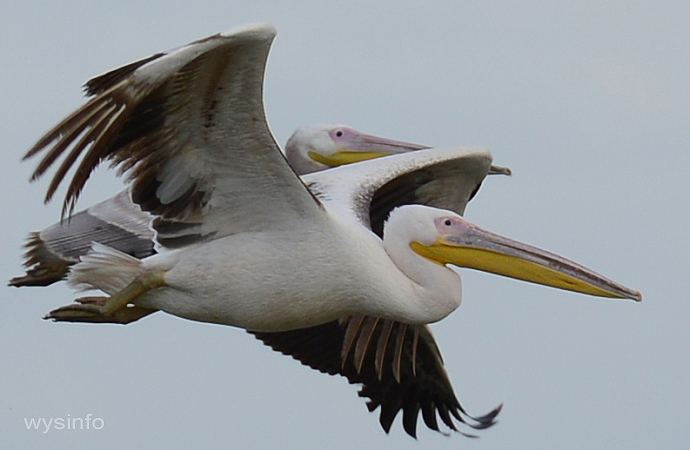
The struggle for survival
Bird migration, like any other migration of mammals or reptiles, is a struggle for survival. This is a struggle in which each life form uses the tools granted to it by nature to the best of its ability.
Species like bears or snakes simply change their metabolism and hibernate. Some fish like the salmon will take a journey of a few thousand kilometers to reach their birthplace to lay their eggs, preparing for the next generation. The caribou and many other animals make an annual journey for the same reason, the need to survive.

While many creatures move about and change locations, there is no doubt that birds have a special advantage – they can fly. The distance that a strong healthy elephant can travel in 3 days can be crossed by a tiny bird in a matter of hours.
What are the special qualities that enable the bird to fly over such great distances? Read more about how birds fly.
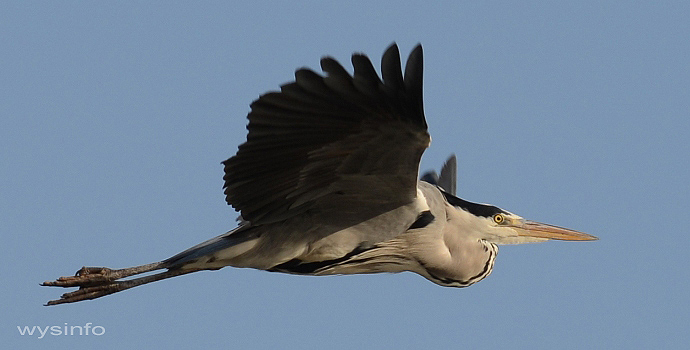
Migration Paths
It is generally accepted that migratory birds around the globe fly over 9 main migration routes, also referred to as flyways. Some of these flyways overlap to an extent.
Bird migration knows no boundaries. It crosses countries, with some of the flyways passing over many dozens of countries. Understanding bird migration provides important knowledge not only for the sake of understanding nature, but also in order to better understand the spread of diseases and to be able to eliminate dangers such as clashes with aircrafts in airplane routes. In order to achieve these goals there is a need for international cooperation. Read more about international cooperation.
The following map shows a commonly accepted outline of the different migration routes.
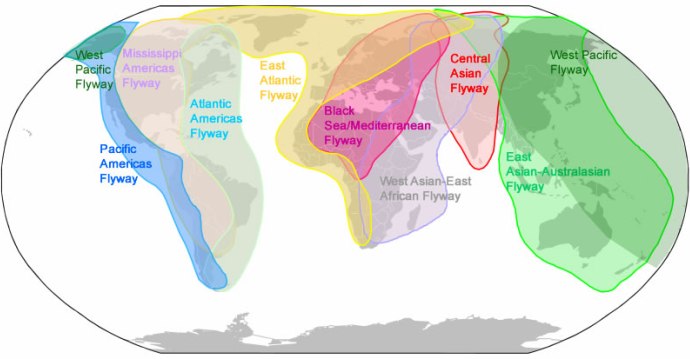
Wikigraphists of the Graphic Lab (fr)
The 9 major accepted flyways are:
- Pacific Americas Flyway
- Mississippi Americas Flyway
- Atlantic Americas Flyway
- East Atlantic Flyway
- Black Sea/Mediterranean Flyway
- West Asian-East African Flyway
- Central Asian Flyway
- East Asian-Australasian Flyway
- West Pacific Flyway
See also alternate map in Migratory Birds – International Cooperation
Crossing Over Israel
There are many places in the world where two or more migratory paths overlap, resulting in a range of various types of migratory birds at different times of the year.
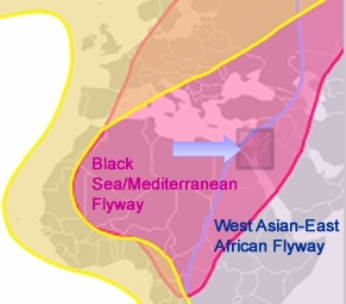
The Black Sea/Mediterranean and the West Asian-East African flyways
The current docuweb focuses on an area that lies beneath two different flyways – the Black Sea/Mediterranean flyway and the West Asian-East African flyway.
In particular we have chosen to look at migratory birds that fly over an area that is located between the Mediterranean Sea and the Jordan River and that includes within it a section of the Great Rift Valley (also known as the Syrian-African Rift).
This area provides an interesting observation point since it presents an ‘over-land’ corridor for many different birds passing from eastern and western Europe and Asia down to Africa, and back.
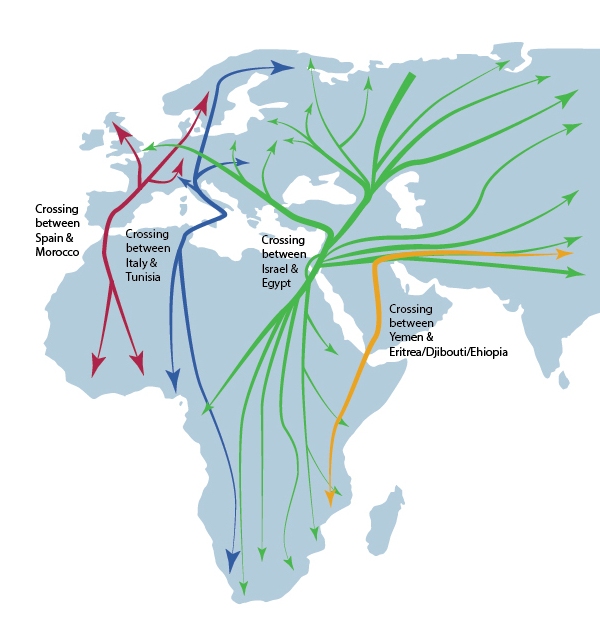
The following is a rough topographical map of the rift valley area, including Lake Kinneret (also known as the Sea of Galilee), the Jordan River and the Dead Sea. It is part of the Syria-African Rift which runs down from northern Syria, through Eilat, to Africa.

Based on Routes of migrating soaring birds, by YOSSI LESHEM1,2 & YORAM YOM-TOV
Some of the migratory birds prefer the route along the Mediterranean shore where they can feed on sea food and fish in the fish farms. Others use the air streams created inland that are intensified by the topography, utilizing them for soaring and gliding, thus achieving longer distances with minimum efforts.
The city of Eilat in the south of Israel, bordered on both sides by mountains, serves as a natural funnel for the paths of many of these birds. It is the last fueling base before the next long flight to Africa along the desert, when they go south, and the first one after the desert when they fly back north. Read more about the migratory birds of Eilat…
How Do Birds Know When to Start Migrating?
The main reason for bird migration is food availability, which is affected by seasonal changes in the climate. However, it is believed that birds in the northern hemisphere know how to time their migration by the change in the day’s light.
It was observed that even when there is a change in the weather that delays harsh conditions so that food is available for a longer period, the birds’ biological clocks nevertheless tell them to start their migration south. The same process works in the spring for the birds in the southern hemisphere.
Deciding which migration route
Some birds will pick up migration routes that provide them with a food supply along the way, sometimes even preferring a longer path because of the food supply. Some others would prefer to take a shorter route, which cannot offer them a food supply but is a safer route, even if it means flying hundreds or more kilometers at one time without refueling.
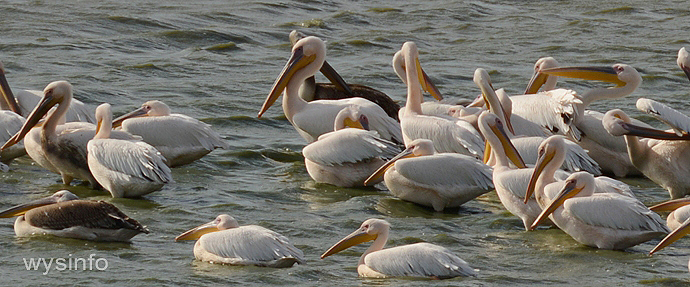
There are birds that fly at a higher altitude than usual during migration, taking advantage of the wind streams, allowing them to save energy. The cool air at these altitudes also helps to lower their temperature during times of exertion.

Grey Heron in Fish Pond – Maagan Michael 
Grey Heron in Fish Pond – Maagan Michael
There are birds that fly at a higher altitude than usual during migration, taking advantage of the wind streams, allowing them to save energy. The cool air at these altitudes also helps to lower their temperature during times of exertion.
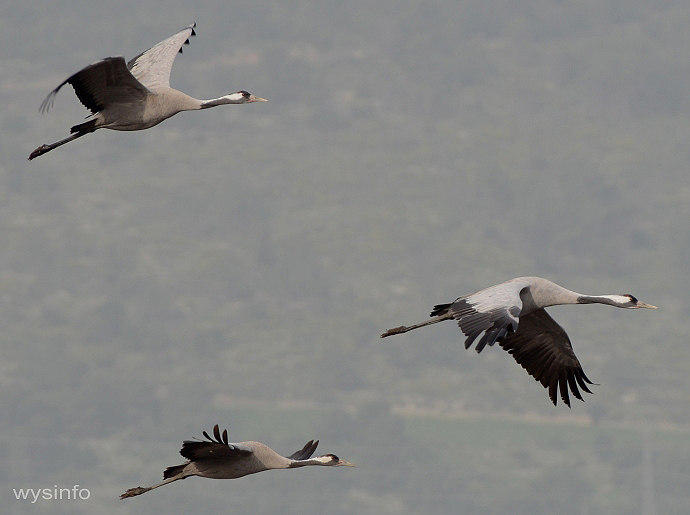
How do birds navigate?
Many attempts have been made to understand bird navigation.
Research made on different bird species suggests that different birds use one or more of the mechanisms described below:
- Magnetic fields – some birds sense the magnetic fields on earth and use this ability to locate and position themselves towards their destination.
- Mapping and memory – some birds map their journey and then recall the route from previous seasons of migration, relating to topography – mountains, valleys, rivers, etc. Birds that experience their first migration also learn the route by simply following the elders in the flocks.
- Sources of light – some use the position of the sun, for those who fly during the day; star mapping and other sources of light for those who fly at night.

How do birds choose their timing?
Some bird species, mostly songbirds, prefer migrating at night since the darkness protects them from predators. Another good reason for flying at night is the fact that the lower temperature in the air keeps their bodies from overheating due to the energy that they are using during the flight.
Migrating during the day has its own advantages for other species of birds, like those birds that use a soaring technique when flying.
They need the thermal air currents, created in the mornings when the sun heats the land and then, consequently, the air above it. The soaring birds use the thermal air current that rises up. Thus, with minimum energy they gain altitude up to a point that they feel is suitable for gliding. Then they direct themselves toward their destination and glide until they hit the next air current. With such tactics they are able to advance many dozens of kilometers with a minimum effort.
Bird preparation for migration
Migration is a necessity for some bird species. It is a tough journey that has its costs. It is roughly estimated that around 60 percent of some birds do not complete the full migration cycle due to dangers that occur on the way. These include: lack of food supply, predators, climatic conditions, legal and illegal hunting, pollution and mistaken navigation due to urban development.
Prior to migration, many birds enter a state of excessive consumption of food. Within a few days their body weight increases with enough fat, which is stored in their fat gland and, to a point, in their flanks. These fat reserves will be converted into energy that will allow them to start the long journey to their seasonal destination. Some bird species can even double their weight during the weeks before migration.
Old damaged feathers are a negative factor for efficient flight. A bird with severely damaged feathers may not make the full migration cycle. Many birds molt (replace old feathers) prior to migration. The new feathers will maximize aerodynamic conditions that will allow the birds to have a proficient more economic and easier flight.

Grouping Migratory and Other Travelling Birds
One way of grouping migratory birds is by the seasons of the year. For example, some birds travel south from a cold northern winter in order to find a more moderate climate. Some birds travel from the southern hemisphere in the autumn in order to find the spring weather of the northern hemisphere. Still others travel north during summer in order to avoid extreme heat.
The following describes the grouping of birds over Israel, which is the area that we are currently focusing on:
- Birds that stay over the summer – those who arrive in the early spring to nest and bring up the new generation in the area over the summer. In the autumn they migrate south to do the winter in Africa, for example Swifts, Blue_cheeked bee-eaters.
- Birds that stay over the winter – those who come to the area in the autumn or in the beginning of the winter, stay throughout the winter and at the end of it fly back to the north to their nesting zones. Examples are Pygmy Cormorant, Cranes.
- Passing migratory birds who pass over the country and stop only briefly. These fly from their nesting zones in the autumn to spend the winter in a warmer climate. Then return in the spring time to their original habitat. Examples are pelicans, flamingos and storks.
- Occasional visitors – Different kinds of birds that come to an area, not intentionally or as a pattern, but often as a result of storms or mistakes in navigation. Birds are referred to as accidental or vagrant if they have strayed a substantial distance outside their expected breeding or migrating range.
Occasional visiting birds
The Pied Bush Chat below is a typical example for the group of occasional visitors. This small passerine bird is usually found in an area ranging from West and Central Asia to the Indian Subcontinent and South East Asia.
We captured the picture, below, in Neot Smadar in the south of Israel in March 2014. This was only the seventh time that someone spotted this bird in Israel, making it a very rare bird for this area.
Indeed during our research we stumbled upon many enthusiastic birders who, having an efficient network of information exchange, drove hundreds of kilometers just to register this bird in their list of birds sited in the area.
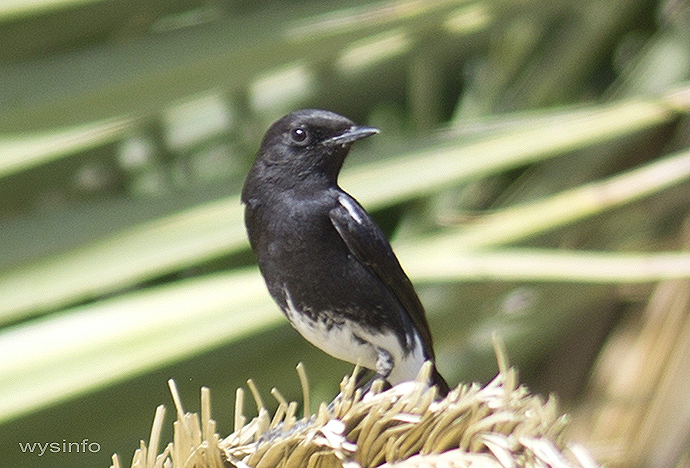
Nomadic and wandering Birds
Nomadic birds move between locations in what appears to be an erratic fashion. These birds seem to be more ‘free spirited’ in their wandering. However the underlying reason for movement remains the same – availability of food and water.
Typically nomadic birds are associated with desert locations and other harsh environments.
Nomadic or wandering Griffon Vultures
One example of a nomadic or wandering bird is the griffon vulture. This vulture can be found nesting among the Gamla cliffs in the north of Israel.

The griffon vulture is one of the most impressive raptures one sees in Israel. It can reach a length of over a meter and wing span of 2.7 meters. Its strength and size enable it, during its daily search for food, to fly distances of over 100 km by soaring and gliding – hardly moving its wings.
The griffon vulture is important for the balance of the ecosystem since it feeds on dead animals. By doing this it clears the environment and helps to prevent the spread of disease. It is well documented by nature reserve authorities, and is considered a protected species.
While some of the vultures in the area are truly migratory (returning seasonally), others have been defined as either nomadic or wandering. This is because they come and go without following a repetitive pattern. It was found that some vultures that made their home in Gamla disappeared from the area after a few years. They were later identified in Spain, and then tracked back to Gamla. Read more about the vultures of Gamla…
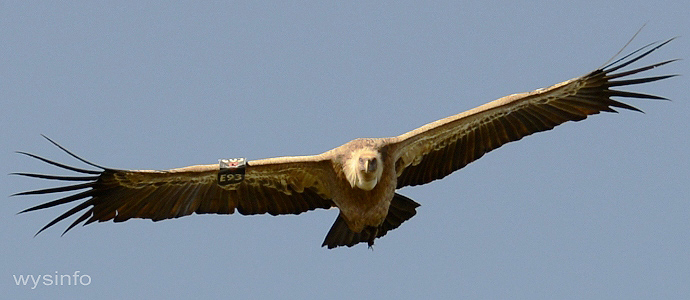
Invasive (immigrant) birds
Invasive birds move into countries where they previously did not reside, sometimes travelling great distances, and establish themselves alongside the indigenous birds. These birds move from one habitat to another since the first location does not accommodate their needs any more.
Often these birds are aggressive and disrupt the natural state of an existing bird population. The mynah bird is one of the most well known invasive species. Many consider them ‘pests’, for example in countries like Australia where there are efforts to control the population of these birds.

Relocated Birds
Relocated birds are moved forcibly by man to a new location. Frequently these birds escape from zoos or cages and successfully establish themselves in the new environment. For example birds like parrots, which are typically indigenous to South America or Asia, are now also living freely, and quickly multiplying, in places like the Middle East. Often these parrots were brought to their new habitat as pets.
